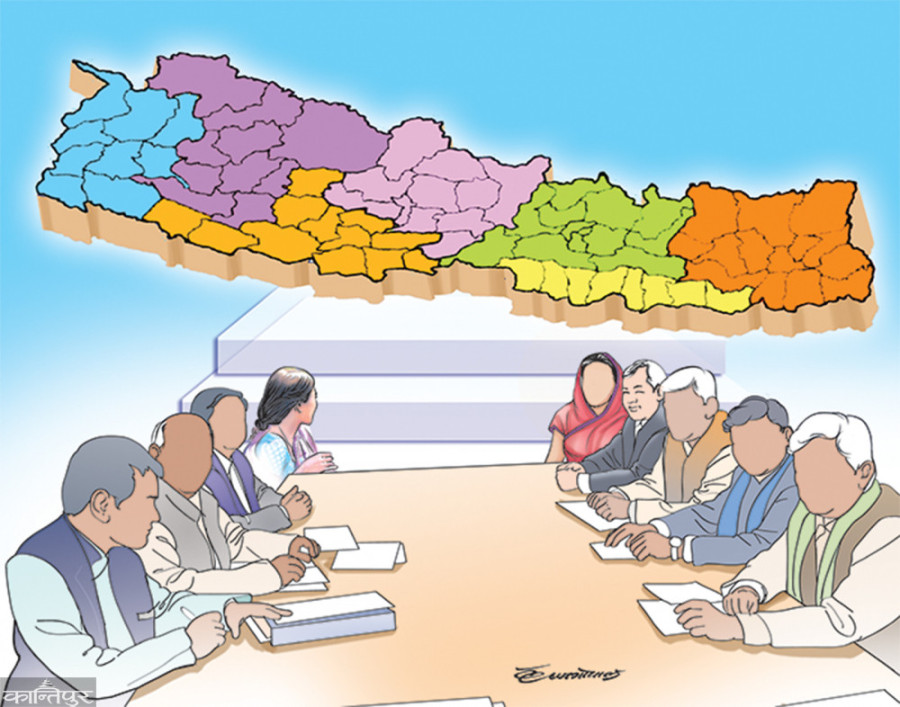Columns
Provincial budgets suffer federal neglect
As the central government significantly reduces fiscal transfers, federalism remains as undermined as ever.
Khim Lal Devkota
The seven provinces of Nepal will present the budget for FY 2024-25 on June 15 as per the mandate of the Intergovernmental Fiscal Arrangement Act 2017. The provinces are in a critical situation at the moment, as many of them are unstable. Over the past year and a half, the provinces have seen altogether 21 chief ministers and 23 floor tests.
The frequent changes in the provincial governments have left the people disappointed with federalism, often questioning the very need of the provinces. However, they are not aware that this is happening due to the behaviour of senior party leaders and the federal government's neglect of the provinces. For instance, the federal government has yet to adjust the police for the provinces. The provision for adjusting police forces for the provinces was included in the budget speech for FY 2023-24 but nothing has been done yet. It seems unlikely to be addressed in the forthcoming fiscal year either, as it has not been included in either the policy and programme or the budget speech for FY 2024-25. Unless the chief ministers sit together at the Prime Minister's residence in Baluwatar, this issue will not be resolved easily or anytime soon.
Downward budget trend
The provinces received an authorisation letter for a fiscal equalisation grant amounting to Rs58.67 billion for FY 2023-24. However, a few weeks ago, the federal government reduced this figure by 26 percent to Rs15.2 billion. This reduction has caused serious problems in the implementation of the provinces' programmes and projects. Furthermore, in the new budget for FY2024-25, the amount of fiscal transfers to the provinces has been significantly reduced. Despite this critical situation, the provinces have surprisingly failed to voice any concerns to the federal government.
Regarding the total budget of the provinces, it was approximately Rs270 billion in FY 2023-24. The main sources of the provincial budget are grants (about 39 percent), followed by revenue sharing (VAT and excise duty), cash balance, and internal revenue. The share of internal revenue in the budget is 16 percent. The largest portion of the provincial budget (65 percent), comes through fiscal transfers, which include both grants and revenue sharing. The fiscal purse of the provinces is so limited that the total budget of the seven provinces from FY 2017-18 to FY 2023-24 was Rs1,586 billion, which is just Rs165 billion less than the budget of the federal government for FY 2023-24.
The tax revenue rights of the provinces are minimal. Increasing the size of the provincial budget is possible only through fiscal transfers. These fiscal transfers are constitutional rights not only for the provinces but also for local levels. The fiscal transfers in the provinces' budget for FY 2024-25 is disappointing.
For instance, in FY 2018-19, the first year full budget of the implementation of federalism, the budget of the Government of Nepal was Rs1,315 billion, while the grant for the provinces was Rs123 billion. This grant was 9.39 percent of the Nepal Government’s budget. The total budget size of the government for FY 2024-25 is Rs1,860 billion, an increase of Rs545 billion over this period.
However, despite the significant increase in the overall budget, the grant for the provinces in FY 2024-25 is only Rs96 billion, which is Rs27 billion less than in FY 2018-19. In FY 2018-19, the provincial grant ratio was 9.39 percent of the government budget. This ratio has declined significantly to 5.18 percent in FY 2024-25. The provinces do not seem to be aware of these figures, but it is disappointing nevertheless.
Federalism neglected
Further, the policies and programmes of the ministries at the federal level have eroded the jurisdiction of the sub-federal levels. The federal government has intervened at the local level. While several sections of the budget mention coordination with the sub-federal levels, there is no actual consultation with these levels when presenting plans and programmes. How can the sub-federal levels take ownership of the plans and programmes developed without their coordination and cooperation?
Article 81 of the Nepal Government’s budget states that Koshi will be developed as an industrial hub, Madhesh as an agricultural centre, Bagmati as an information technology hub, Gandaki as a tourism centre, Lumbini as a centre for small and medium industries, Karnali as a herbal hub, and Sudurpaschim as a religious tourism centre. However, there is no coordination with the provinces. These announcements have been made unilaterally without consultation with the provinces. Similarly, the budget mentions the Gandaki Economic Triangular Project concept without coordinating with the related provinces. Why has the federal government not discussed and consulted with the provinces regarding policies, programs, and potential plans?
The constitution of Switzerland states that the federal government should consult with stakeholders, including the cantons (provinces), before implementing any new laws, programmes or projects. This consultation process is one of the key reasons for Switzerland's significant development across various sectors. For those affected by laws and policies, close discussions and consultations are essential to ensure full ownership and facilitate implementation, thereby promoting development.
The rulers at the federal level have a centralist mindset. It should also be noted that in the Supreme Court decision related to the Giribandu Tea Estate, the court stated that sub-federal levels should be consulted when drafting any new bills related to concurrent rights. If one day, the Supreme Court decides on issues related to plans, programmes, and fiscal transfers and declares them unconstitutional, it should not be assumed otherwise.
Centralist budget
Consider the budget from the perspective of ministerial allocation. According to the constitution, the responsibilities of ministries such as Finance, Defense, Foreign Affairs and the Prime Minister's Office are central in nature. However, the responsibilities of most other ministries are connected to the sub-federal levels. Despite this, the Ministry of Forestry has allocated only 18 percent of its total budget, and the Ministry of Federal Affairs and General Administration only 11 percent for the provinces. The Ministry of Urban Development has allocated 8 percent, the Ministry of Health 7 percent, the Ministry of Water Supply 5 percent, the Ministry of Women 3 percent, the Ministry of Education 2 percent, and the Ministry of Labor only 1 percent of their budgets for the provinces. Several ministries, including Tourism, Industry, Home, Sports, Physical Infrastructure, Land and Cooperatives, Communications, and Law, have not allocated any funds to the provinces. The Ministry of Energy, Water Resources and Irrigation has allocated only 0.7 percent of the total budget for the provinces.
Most of the budget of the Ministry of Education and Labor is allocated to the local level, which is not an issue. However, it is unfortunate that the development ministries' budgets are not allocated to the provinces, as this undermines the essence of provincial governance. The constitution considers the province a key actor in development, but the budgets that should go to the provinces have been withheld by these Singadurbar-based ministries.
Even an analysis of ministerial budget allocations from the first budget of federalism implementation (FY 2018-19) to FY 2024-25 reveals that except for 8 to 10 ministries, all others have reduced the jurisdiction of the sub-federal levels. I have detailed the analysis of ministries' programmes and projects for FY 2023-24 in this newspaper. I find that we do not need more than eight to 10 ministries at the federal level. When more than 60 percent of the functional responsibilities have been devolved to the sub-federal level, why do we need many ministries at the federal level? In Switzerland, there are only seven ministers at the federal level, including the President.
To conclude, as the provinces prepare to present their budgets, they continue to suffer due to the federal government’s neglect of them. Fiscal transfers to the provinces have been significantly reduced, undermining federalism. Frequent changes in provincial governments, lack of support from the federal level, and insufficient coordination on policies and budgets complicate this issue.




 19.12°C Kathmandu
19.12°C Kathmandu














